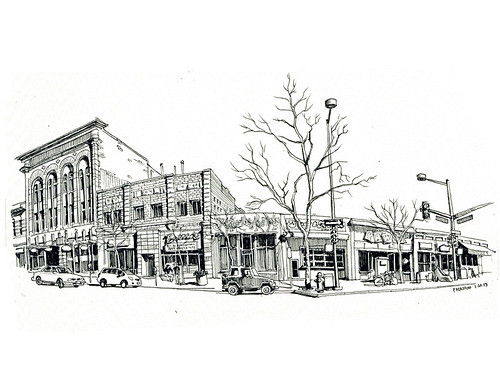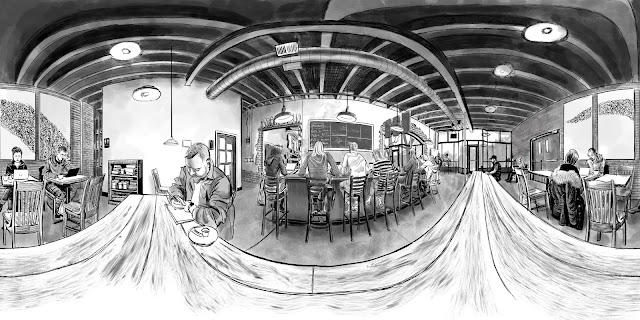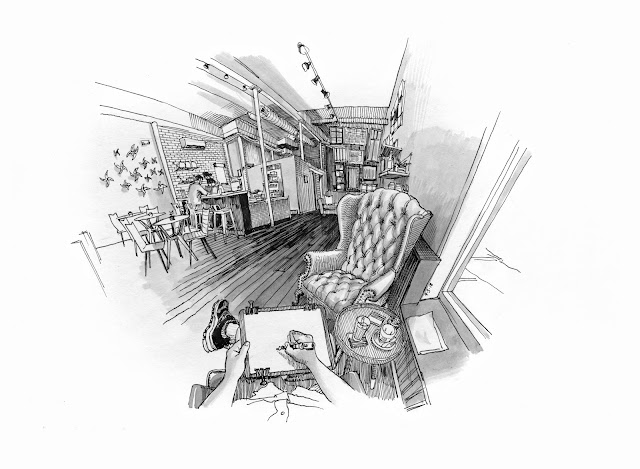I rarely take pictures of sketches as they're progressing, mostly because I can never remember to, but also because I don't like to stop working to take a photo. However, long-term projects like the Main Street Bozeman sketchbook or the San Antonio panorama are easier to document as they progress, and I have scanned a few in progress before. But I also recently documented the step-by-step process of a few drawings in the field for a project by a fellow sketcher that I'm contributing to.
Here's a set of steps I think I can share:
 |
| The location to be sketched. |
 |
| In this case, as with many other larger sketches, I used a pencil first before going in with a pen. I start with a few basic lines that establish the overall shape of the composition. These lines will serve as a rough guide for the curved perspective I plan to use in the drawing. |
 |
| After that, basic shapes are blocked in, as well as the location of certain foreground elements, like trees. |
 |
| I add more interior details as the sketch progresses, and more foreground elements. |
 |
| When I'm satisfied with the amount of pencil-work, I start with ink. I tackle the cars first, as they have the potential to leave without warning! |
 |
| From the cars I move backward through trees, signs, trash cans and parking meters before I get to the building. |
 |
| I start in with value right away, rather than finishing the entire sketch as a contour line drawing before putting in the darks. |
 |
| Getting there... |

The final product.
I've also just started working (okay, a month ago) on a long-term Denver project in a folding Moleskine that Linda gave me. I intend for it to be a full 360
° panorama this time. I found a round concrete bench that circles a small flowerbed outside of the Brown Palace hotel which has great view in all directions.
Here's the scanned progress on that project, 4 days in:




















Thanks for sharing your process . . . what do mean by "cleaned up in Photoshop?"
ReplyDeleteThanks for the detail description. Looks great.
ReplyDeleteThanks both of you! Mark, that's a good question. When I scan a drawing into photoshop, often times the paper has too much texture or has uneven spots of light and dark. So I do a few things. I adjust the contrast and lightness so the white of the paper becomes pure white. However, this can sometimes thin the black lines, so before I do this I go over the whole drawing with the paintbrush set to "hard mix" and set at about 11% opacity. This thickens up the lines enough that they won't disappear when the lightness/contrast is adjusted.
ReplyDeleteI've spent the last 20 minutes looking through this blog, and it's reduced me to tears, twice. I'm an art student and I struggle EVERY DAY with not being good enough. I want to draw this well... with all this detail... but I'm so impatient. All your work is so incredibly lovely.
ReplyDeleteYou're very kind. It makes my day when someone likes my work. As far as being frustrated/impatient, the only advice I can give is to keep at it. It's a cliche, and it will definitely try your patience, but keep on going. I try to draw every day. When I was an art student I felt the same kind of frustration you do, but I stuck with it, even when I didn't want to. I still get to the point where I feel something isn't working, but I've learned that it passes.
ReplyDeleteOne of my teachers told me that your mind is always five years ahead what your hand is capable of, and it kills me a little. I think before I was a student of art, I was a parishioner of beauty... and so when I see or feel all these beautiful things it actually hurts my heart when I can't get it on the page. I think about it too much. Practiced and skilled people often tell me that I'm putting too much pressure on myself... and maybe I am, but it feels like it's so much easier said than done. I'm continuing to try to be patient, and to continue to hone my skills, but I think on some level it hurts me far more than it does the average student, and it's crippling. I'll keep checking out your blog. You're a huge inspiration! Thanks so much for replying to me!
Deletevery well documented, simple, pertinent , generous, as your drawing, am too deeply moved by your art.
ReplyDeleteLove your work, and it's fascinating to see your process. Any particular reason you start with value rather than finishing the contour first?
ReplyDeleteIn this case I wanted to capture the shadows on the buildings before the light changed. The buildings face west, so at a point in the late afternoon they'd be illuminated too flatly, and features like the window casings and vestibules wouldn't cast very strong shadows. In other situations I might do the contour first, before the shadows get interesting, then do them all at once a little later.
DeletePaul, thanks for sharing your works in progress. It's very inspiring and it helps alot! As a sketching beginner, I always feel sorry for taken too long to finsih a sketch, do you limit the time you spend on a sketch? What advice can you suggest on using the time wisely on the drawing. Thanks Master!
ReplyDeleteHi Alvin, that's a good question. I usually take as much time as I need. Sometimes I know I don't have much time, so I have to think about that when I start. But there's nothing wrong with taking as much time as you need. I'm slow compared to others, but I think it's okay.
DeleteThanks for sharing your process, it is incredible work, I really like your style!
ReplyDeleteThanks! Much appreciated.
Delete